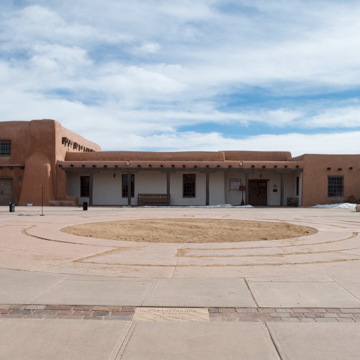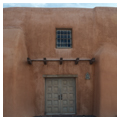John Gaw Meem’s first institutional commission, the Laboratory of Anthropology brought Meem national attention and was an important step in formulating the Spanish Pueblo Style that he then codified in his buildings for the University of New Mexico.
Overlooking Santa Fe from its hilltop site at the edge of the Santa Fe National Forest, the Laboratory of Anthropology was founded in 1927 by John D. Rockefeller Jr., who, after visiting Santa Fe in 1924 and 1926, pledged funds for the construction of an anthropological center dedicated to the collection, study, and preservation of the Southwest’s indigenous cultures. Specializing in archaeology, ethnology, linguistics, and physical anthropology, the Laboratory was a privately funded rival to the School of American Archaeology and Museum of New Mexico that Edgar Lee Hewett had founded in 1907 and 1909 respectively. Jesse Nusbaum, one of the Museum’s original staff, became the Laboratory’s director, the first of many who switched institutions after the Laboratory opened in 1931. While the Museum had emphasized the Spanish Colonial period and artistic artifacts made after 1598, the Laboratory of Anthropology focused on New Mexico’s pre-Spanish past of Puebloan arts and culture. This competition would goad Hewett to expand his archaeology department and establish a new Department of Ethnology focused on researching and collecting Indian Art.
Rockefeller initially envisioned a complex of 38 buildings, including a library, museum, Navajo building, and residential and service buildings in addition to the laboratory facilities, which collectively would create a cohesive historic environment akin to the restoration of Williamsburg, Virginia, that he had funded since 1926. A national competition to design the Laboratory was held under the auspices of the American Institute of Architects in 1929. A local committee headed by Sylvanus Morley, another member of Hewett’s staff at the Museum of New Mexico, awarded the commission to John Gaw Meem. Of the 38 planned buildings, only two were built: the Laboratory of Anthropology, and the Director’s Residence, which today houses the Spanish Colonial Arts Society.
Meem had come to New Mexico in 1920. He soon met Carlos Vierra, a painter and staff member of the Museum of New Mexico; there, Vierra was actively involved with Morley and others in the effort to identify New Mexico with the Santa Fe or Spanish-Pueblo Style that had been adopted for Rapp, Rapp, and Hendrickson’s Museum of Art (1915–1917). Joining this group, Meem established himself as one of the style’s key proponents and practitioners, first with a series of residential commissions and then in 1929 with his addition to Rapp, Rapp, and Hendrickson’s La Fonda Hotel (1919–1922). He was the obvious choice to design the Laboratory of Anthropology.
The building is organized functionally into public and private zones, with a two-story lounge and gallery spaces to the north connecting to an L-shaped wing on the south housing administrative and staff offices as well as a survey and records room. The structure of brick and hollow clay tile is finished with cement stucco that has been built up in layers and given a brown finish coat to mimic the sculpted contours and color of adobe. The projecting beam ends and the portico ( portal) fronting the gallery—with its rough-hewn posts, corbel capitals, and beams— completes the illusion that this is a traditional, handcrafted structure of earth and timber. The effect continues inside, where one finds carved wooden furniture and doors, tinwork light fixtures and chandeliers, flagstone floors, corner fireplaces and ornate woodwork throughout the lounge and gallery spaces. In the lounge, sculptural stairs lead to a balcony that recalls the choir lofts of mission churches, and intricately carved vigas support a ceiling of latillas laid in herringbone pattern.
Even though the competition had proscribed Spanish Colonial architecture, Meem followed the example set by Rapp and Rapp’s New Mexico Museum of Art and turned to mission churches to justify an eclectic blending of Puebloan and Spanish models. In its general form, the main elevation evokes the mission church and attached friary ( convento) of San Esteban at Acoma Pueblo. The asymmetrical and purely decorative buttresses on the two-story lounge to the north are modeled after those on the iconic Ranchos de Taos Church. Yet the stepped profile and plain surfaces of the building’s south elevation looks to the stepped housing blocks of pueblos.
Rockefeller’s initial funding lasted only five years and the Laboratory of Anthropology faced increasing financial difficulty in the wake of the Great Depression. In 1947, it merged with the Museum of New Mexico to create the largest and most comprehensive collection of Southwestern archaeological, ethnographic, and artistic artifacts in the country. The Museum of Indian Arts and Culture, a 31,000-square-foot exhibition space, was opened next to the Laboratory in 1987 to house and display its collections.
The Laboratory of Anthropology today houses a library and research center dedicated to the Southwest’s indigenous cultures, and is open to the public during regularly scheduled hours.
References
Bunting, Bainbridge. John Gaw Meem: Southwestern Architect. Albuquerque: University of New Mexico Press, 1983.
“History of the Laboratory of Anthropology and the Museum of Indian Arts and Culture.” Museum of Indian Arts and Culture. Accessed February 19, 2016. http://www.indianartsandculture.org/.
Jackson, Marsha F, “Laboratory of Anthropology,” Santa Fe, New Mexico. New Mexico State Register of Cultural Properties Application for Registration Form, 1982. New Mexico Historic Preservation Division, Santa Fe, NM.
Kammer, David, “Buildings Designed By John Gaw Meem,” Santa Fe, New Mexico. New Mexico State Register of Cultural Properties Application for Registration Form, 2002. New Mexico Historic Preservation Division, Santa Fe, NM.
Maxwell, Tim. “Archaeology at the Museum of New Mexico.” New Mexico Office of Archaeological Studies. Accessed February 19, 2016. http://www.nmarchaeology.org/.
Wilson, Chris. The Myth of Santa Fe: Creating a Modern Regional Tradition. Albuquerque: University of New Mexico Press, 1997.
Wilson, Chris. Facing Southwest: The Life & Houses of John Gaw Meem. New York: W.W. Norton & Company, 2001.























